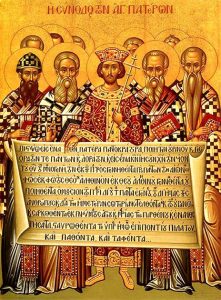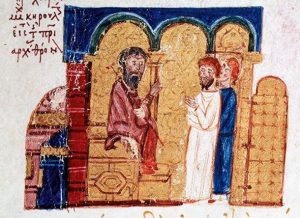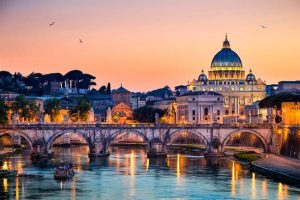East vs. West: The Untold Story of the Great Schism in Christianity

Christianity is one of the foremost religions in the world. It has a long history, which was often fraught with crises, struggles, and persecutions. Of course, as the centuries passed, so did religious beliefs, the teachings and the fundamental rules. And in time, Christians began acquiring different points of view about their religion. Because of this, the original Christianity began branching, and after the Great Schism it split into two separate schools of thought. They shaped the development of the world for centuries that followed.
The Great Schism Separates the Christians
The Great Schism, also known as the East-West Schism or the Schism of 1054, was a significant event in Christian history that resulted in the split between the Eastern Orthodox Church and the Western Roman Catholic Church. This schism had profound religious, cultural, and political implications, shaping the course of Christianity for centuries to come. As Christianity became the dominant religion in medieval and Renaissance Europe, the split caused some significant ripples in society, politics, and the flow of history itself.
For many generations after the death of Christ, Christians were persecuted and had to adhere to their faith in secrecy. Only in 313 AD, at the Edict of Milan, was their religion decriminalized and accepted across the civilized world. In 380 AD it became the state religion of the Roman Empire, and quickly rose as the foremost European religion. It endured this way for several centuries, but by the time of the Middle Ages, differences between teachings began to emerge, all leading up to the Great Schism.
Doctrinal differences played a central role in the Great Schism, reflecting long-standing theological disputes that gradually intensified over the centuries. These differences encompassed various aspects of Christian doctrine, including theological nuances and ecclesiastical practices. Theological disputes had been brewing for centuries between the Eastern and Western Churches. Issues such as the nature of the Holy Spirit, the use of unleavened bread in the Eucharist, and the authority of the Bishop of Rome (the Pope) were among the key points of contention.

Pope Leo IX (1049–1054) was a key figure during the Great Schism. While his papacy set the stage for tensions, the formal split occurred after his death, marked by mutual excommunications in 1054. (Public domain)
Centuries of Divide: The History of the Great Schism
One of the most significant doctrinal disagreements revolved around the inclusion of the term “filioque” in the Nicene Creed. The original Nicene Creed, established at the First Council of Nicaea in 325 and later modified at the First Council of Constantinople in 381, affirmed the procession of the Holy Spirit from the Father alone.
In the West, particularly in the Latin-speaking Church, the phrase “filioque” (“and the Son”) was added to the Nicene Creed. This addition stated that the Holy Spirit proceeds from both the Father and the Son. However, the Eastern Church, which used the original Nicene Creed without the filioque clause, viewed this as an unauthorized modification of a creed established by an ecumenical council. The filioque controversy became a symbol of theological and cultural differences, contributing significantly to the schism.
The issue of papal authority and the primacy of the Bishop of Rome, the Pope, was another doctrinal point of contention. The Pope claimed a position of supremacy over the entire Christian Church, asserting the authority to make doctrinal decisions and intervene in the affairs of other patriarchates. In contrast, the Eastern Church, particularly the Patriarchate of Constantinople, emphasized a more conciliar model of governance. While recognizing the historical importance of Rome, the East did not accept the Pope’s claim to unilateral authority. This divergence in ecclesiastical governance and authority contributed to the rift.
Beyond specific doctrinal formulations, there were differences in liturgical practices and ecclesiastical traditions. The use of different languages in worship services (Latin in the West, Greek in the East) and variations in liturgical rites contributed to a sense of cultural and religious divergence. Additionally, the Eastern Church had a strong emphasis on mysticism and theosis (the process of becoming one with God), while the Western Church, influenced by Latin theology, had its distinctive theological emphases.

Doctrinal disagreements played a fundamental role in the origin of the Great Schism, such as the inclusion of the term “filioque” in the Nicene Creed. Icon depicting the Emperor Constantine and the bishops of the First Council of Nicaea (325) holding the Niceno–Constantinopolitan Creed of 381. (Public domain)
Heated Disagreements Within Christianity
Political factors also played a role. The power struggle between the Patriarch of Constantinople and the Pope in Rome, as well as the interference of secular rulers in ecclesiastical affairs, further strained relations. These factors were often intertwined with broader geopolitical developments and power struggles within both the ecclesiastical and secular spheres.
In the Eastern Roman Empire, centered in Constantinople, the relationship between the emperor and the Patriarch of Constantinople was often characterized by a strong imperial influence over ecclesiastical affairs. Emperors sought to exert control over the Church to solidify their authority and maintain political stability. Similarly, in the Western Roman Empire, especially as it transitioned into the Holy Roman Empire, there was a tradition of cooperation between the Pope and secular rulers. The concept of “papal supremacy” grew, with the Pope becoming a spiritual authority and, at times, a political power broker.
The Bishop of Rome, known as the Pope, began asserting claims to universal jurisdiction and supremacy over the entire Christian Church. This claim to authority extended beyond spiritual matters and encompassed political and doctrinal domains. The Pope’s efforts to assert authority over other patriarchates, including the Patriarchate of Constantinople, led to tensions and resistance from Eastern bishops who were wary of what they perceived as an encroachment on their traditional autonomy.
“If the Roman Pontiff, seated on the lofty throne of his glory, wishes to thunder at us and, so to speak, hurl his mandates at us from on high, and if he wishes to judge us and even to rule us and our Churches, not by taking counsel with us but at his own arbitrary pleasure, what kind of brotherhood, or even what kind of parenthood can this be? We should be the slaves, not the sons, of such a Church, and the Roman See would not be the pious mother of sons but a hard and imperious mistress of slaves.”
The Iconoclastic Controversy in the 8th and 9th centuries, which involved debates over the use of religious icons, had political ramifications as well. While both East and West were affected, the resolution of the controversy in the East without significant input from the Pope heightened suspicions in the West about the Eastern Church’s independence and self-governance. Adding to the tension was the spread of Christianity into areas such as Eastern Europe and the Balkans brought questions of ecclesiastical organization and jurisdiction. The competing interests of the Roman Catholic Church and the Eastern Orthodox Church in missionary activities and the establishment of ecclesiastical structures in newly converted regions created tensions.

The formal beginning of the Great Schism is said to have taken place in 1054 AD, when Michael Cerularius, seen during his enthronement here, and Cardinal Humbert excommunicated each other. (Public domain)
The Great Schism Happens
In 1054 AD, the Patriarch of Constantinople, Michael Cerularius, and the Papal Legate, Cardinal Humbert, excommunicated each other in what is considered the formal beginning of the schism. This act symbolized the irreparable rupture between the Eastern and Western Churches. The exchange of anathemas, or formal curses, between the East and West deepened the divisions. The Eastern Orthodox Church and the Roman Catholic Church were now officially separate entities. These excommunications were the culmination of a long-standing and multifaceted conflict that threatened to erupt into something far greater.
In 1054, Pope Leo IX sent a papal legate, Cardinal Humbert of Silva Candida, to Constantinople with the mission of resolving the ongoing disputes. However, instead of fostering reconciliation, the events took a turn for the worse. During a liturgical service at the Hagia Sophia, Cardinal Humbert placed a bull of excommunication on the altar. This bull, known as the “Bull of Excommunication Against Patriarch Michael Cerularius,” contained strong language denouncing the actions and beliefs of the Eastern Church. In response, Patriarch Michael Cerularius issued a counter-anathema, excommunicating Cardinal Humbert and his associates. This reciprocal exchange of anathemas marked the formal separation between the Eastern Orthodox Church and the Roman Catholic Church.
The mutual excommunications symbolically severed the ecclesiastical ties between East and West. It signified that the breach had reached a point of no return, and the two churches were now officially in a state of schism. The anathemas reflected not only specific accusations but also a deeper doctrinal and cultural divide. The excommunications emphasized the irreconcilable differences in theological understanding, liturgical practices, and ecclesiastical governance. Needless to say, this was the point of no return – and affected the relationship between the East and the West immensely.
The Formation of Two Churches
The Great Schism led to the establishment of the Eastern Orthodox Church, with its center in Constantinople, and the Roman Catholic Church, centered in Rome. Each developed its distinct traditions, doctrines, and ecclesiastical structures. The Eastern Orthodox Church, emerging from the traditions of the Byzantine Empire, maintained a conciliar model of governance. The autocephalous nature of its various patriarchates, including Constantinople, Alexandria, Antioch, and Jerusalem, allowed a degree of independence, with each patriarchate having its own local synod. It retained its rich liturgical traditions, heavily influenced by Byzantine rites. The use of the Greek language in worship services became a distinctive feature, and the liturgical calendar followed the Eastern Orthodox liturgical year.
The Roman Catholic Church, centered in Rome, maintained a hierarchical structure with the Pope at its apex. The Pope claimed authority over the entire Christian Church, asserting papal supremacy. The centralized authority of the Pope allowed for a more unified governance structure. Latin was the liturgical language of the Roman Catholic Church, distinguishing it from the Eastern Orthodox Church. The Latin liturgy, with its rites and traditions, was used in worship services across Western Christendom.
The schism had lasting effects on the Christian world, contributing to the development of Eastern Orthodoxy and Roman Catholicism as distinct traditions. It also influenced the course of history, including the Crusades and the relationships between Eastern and Western Europe. Over the centuries, various attempts were made to heal the schism, but none resulted in full unity. In recent decades, there have been dialogues between the Catholic Church and the Eastern Orthodox Church, fostering better understanding and cooperation.

As the seat of the Roman Catholic Church and the residence of the Pope, the Vatican was central to the events of the Great Schism. Night view of the Basilica St Peter in Rome, Italy. (Mapics / Adobe Stock)
The Great Schism Forged an Unbridgeable Gap
There is no doubt that the schism influenced the geopolitical landscape of medieval Europe and the Byzantine Empire to a great extent. The Eastern Orthodox Church became deeply rooted in the Byzantine world, while the Roman Catholic Church played a central role in the development of Western Christendom. Many wars erupted between the adherents of the two churches, and once brotherly nations were irreversibly divided because of their respective churches. Because of the Great Schism, the world saw immense bloodshed and persecution, and Europe was separated in two.
In recent decades, there have been dialogues and efforts towards mutual understanding between the Eastern Orthodox Church and the Roman Catholic Church. While progress has been made, significant theological and ecclesiastical differences persist. Catholicism and Eastern Orthodoxy still remain fundamentally different. Add to this the different Christian denominations such as Protestantism, Restorationism, and many others, and you get a complex religious backdrop which divides believers who – in principle – adhere to the same faith.